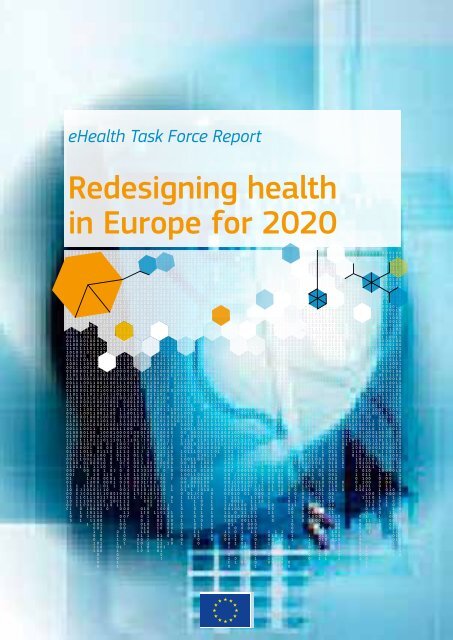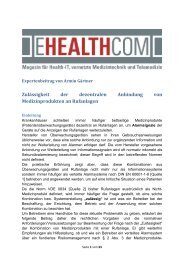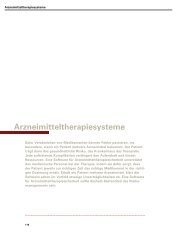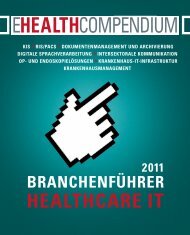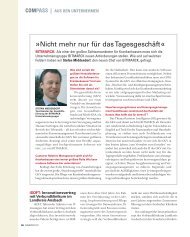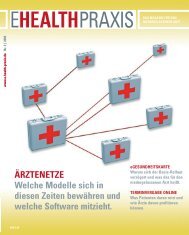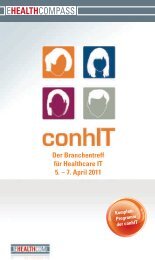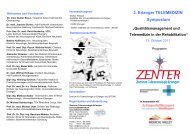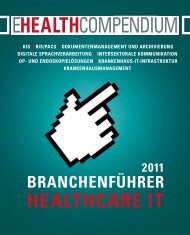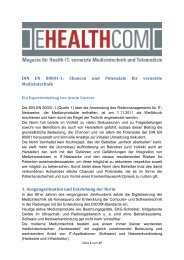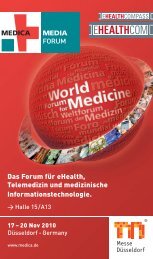eHealth Task Force Report - E-Health-Com
eHealth Task Force Report - E-Health-Com
eHealth Task Force Report - E-Health-Com
You also want an ePaper? Increase the reach of your titles
YUMPU automatically turns print PDFs into web optimized ePapers that Google loves.
<strong>e<strong>Health</strong></strong> <strong>Task</strong> <strong>Force</strong> <strong>Report</strong><br />
Redesigning health<br />
in Europe for 2020
Europe Direct is a service to help you find answers<br />
to your questions about the European Union.<br />
Freephone number (*) :<br />
00 800 6 7 8 9 10 11<br />
(*) Certain mobile telephone operators do not allow access to 00 800 numbers or these calls may be billed.<br />
More information on the European Union is available on the Internet (http://europa.eu).<br />
Cataloguing data can be found at the end of this publication.<br />
Luxembourg : Publications Office of the European Union, 2012<br />
ISBN 978-92-79-23542-9<br />
doi:10.2759/82687<br />
© European Union, 2012<br />
Reproduction is authorised provided the source is acknowledged.<br />
Printed in Belgium<br />
Printed on recycled paper
Table of Contents<br />
Foreword . . . . . . . . . . . . . . . . . . . . . . . . . . . . . . . . . . . . . 5<br />
Introduction . . . . . . . . . . . . . . . . . . . . . . . . . . . . . . . . . . . . 7<br />
<strong>e<strong>Health</strong></strong> .in .2020 .– .5 .levers .for .change . . . . . . . . . . . . . . . . . . . . . 9<br />
Lever for change #1: My data, my decisions . . . . . . . . . . . . . . . . . . . . . . . . . . . 9<br />
Lever for change #2: Liberate the data . . . . . . . . . . . . . . . . . . . . . . . . . . . . 10<br />
Lever for change #3: Connect up everything . . . . . . . . . . . . . . . . . . . . . . . . . 11<br />
Lever for change #4: Revolutionise health . . . . . . . . . . . . . . . . . . . . . . . . . . . 12<br />
Lever for change #5: Include everyone. . . . . . . . . . . . . . . . . . . . . . . . . . . . . 13<br />
Recommendations .for .action . . . . . . . . . . . . . . . . . . . . . . . . . . 15<br />
Recommendation I: A new legal basis for health data in Europe . . . . . . . . . . . . . . 15<br />
Recommendation II: Create a ‘beacon group’ of Member States<br />
and regions committed to open data and <strong>e<strong>Health</strong></strong> . . . . . . . . . . . . . . . . . . . . . . 15<br />
Recommendation III: Support health literacy . . . . . . . . . . . . . . . . . . . . . . . . . 16<br />
Recommendation IV: Use the power of data. . . . . . . . . . . . . . . . . . . . . . . . . . 16<br />
Recommendation V: Re-orient EU funding and policies . . . . . . . . . . . . . . . . . . . 17<br />
<strong>e<strong>Health</strong></strong> <strong>Task</strong> <strong>Force</strong> <strong>Report</strong> – Redesigning health in Europe for 2020 | 3
Foreword<br />
Demography is one of the few<br />
areas of social science where we<br />
can predict the future. We know<br />
how many old and retired people<br />
Europe will have in 8, 28 or 48<br />
years, as well as how many people<br />
of working age we will have<br />
to support them. In this regard,<br />
the future in Europe, barring any<br />
extreme developments, does not<br />
look good.<br />
Europe is aging, the proportion of the elderly in our countries<br />
is increasing, due both to fewer children as well as increased<br />
life spans. How can we ensure that European healthcare in the<br />
future will be affordable, will not burden our economies and at<br />
the same time keep up with the latest advances in medicine?<br />
Moreover, in a Europe of increasing mobility, how do ensure<br />
that patients can be assured the highest quality of healthcare<br />
everywhere in the Union?<br />
We know that in healthcare we lag at least 10 years behind<br />
virtually every other area in the implementation of IT solutions.<br />
We know from a wide range of other services that information<br />
technology applications can radically revolutionise and<br />
improve the way we do things. We know as well, from innovative<br />
approaches already used around the EU, that many<br />
solutions to the impending crisis in healthcare already exist.<br />
In other words, by implementing IT solutions to preventative<br />
and ongoing healthcare we can make life better for patients,<br />
indeed for all who require our healthcare services.<br />
The following report outlines the <strong>Task</strong> <strong>Force</strong>’s conclusions<br />
regarding the key issues faced by a fundamental re-organisation<br />
of healthcare to make use of already existing information<br />
technologies. These solutions are often not medical at all, but<br />
rather deal with how in the future we will need to treat data,<br />
privacy, research as well as the physician/patient relationship.<br />
Since not only EU citizens but also their data move across borders,<br />
we require an EU approach, where we harmonise our legislation<br />
so everyone can operate using the same rules. If we fail to do<br />
this, we can rest assured that other solutions will be found, either<br />
mutually incompatible national rules or private sector initiatives,<br />
where our fundamental rights may not be guaranteed.<br />
The task we face is to ensure that in the future all EU citizens<br />
have access to a high level of healthcare, anywhere in the<br />
Union, and at a reasonable cost to our healthcare systems. To<br />
do so, we must make use of solutions offered by information<br />
technology already today. This, ultimately, is the fundamental<br />
conclusion of the <strong>Task</strong> <strong>Force</strong>’s report, Redesigning health in<br />
Europe for 2020.<br />
Toomas .Hendrik .Ilves<br />
President, Estonia<br />
Chairman of the EU <strong>Task</strong> <strong>Force</strong> on <strong>e<strong>Health</strong></strong><br />
<strong>e<strong>Health</strong></strong> <strong>Task</strong> <strong>Force</strong> <strong>Report</strong> – Redesigning health in Europe for 2020 | 5
8. AWG reference scenario. As discussed above,<br />
actual spending on health care is a combined<br />
result of the whole set of interrelated demographic<br />
and non-demographic factors. Therefore, any<br />
measurement of separate effects of individual<br />
factors, as modelled in the sensitivity tests, can<br />
only provide a very partial view of the future.<br />
Furthermore, given the complexity of those<br />
interconnections and difficulties in defining the<br />
most probable course of development in the<br />
underlying variables, the projection is subject to<br />
high uncertainty. Nonetheless, even if highly<br />
risky, an attempt to choose a highly plausible<br />
scenario is a potentially very informative<br />
Introduction<br />
exercise, notably in the context of the analysis of<br />
sustainability of public finances policy and the<br />
public health care provision, both of which need<br />
to be based on the most reliable forecasts of the<br />
3.5. projection results<br />
The results of the health care projection exercise<br />
should be interpreted with due caution. More<br />
emphasis should be put on the expected impact<br />
of the respective factors than on the resulting<br />
overall level of expenditure.<br />
3.5.1. the impact of future changes<br />
in demography and the health status<br />
The impact of demographic changes on public<br />
health expenditure is projected to be significant<br />
(an average (EU27) increase from 6.7 to 8.4% of<br />
GDP), although not equally pronounced across<br />
all countries. The increase varies from 0.4% of<br />
GDP in Bulgaria and Latvia to 3.8 % of GDP in<br />
Malta (or, in relative terms, from 6 to 80% of the<br />
initial level), but for most countries it is contained<br />
In 2020 the health and health care of our citizens could look<br />
quite different. We find ourselves today on the threshold of a<br />
new era with many opportunities for radical improvements in<br />
the way we manage and receive health care. In order to ensure<br />
the sustainability of our health care systems, there is a need<br />
to tackle considerable challenges.<br />
This report focuses on how to achieve a vision of affordable,<br />
less intrusive and more personalised care. Ultimately, increasing<br />
the quality of life as well as lowering mortality. Such a<br />
vision depends on the application of ICT and the use of data.<br />
The <strong>Task</strong> <strong>Force</strong> behind this report was convened to explore<br />
the potential of ICT in health innovation in the EU and make<br />
recommendations on what could be done now to ensure that<br />
Europe reaps the full benefits of <strong>e<strong>Health</strong></strong> in 2020.<br />
conditions linked to unhealthy lifestyles, expensive new technologies<br />
and products, the need for more specialised skills and<br />
the demand for high level care (Graph 1).<br />
As Europe ages, the older population will be living with several<br />
health conditions which need ongoing monitoring and<br />
management. Chronic disease, already 80 % of the disease<br />
burden, continues to rise – driven by the explosion in unhealthy<br />
lifestyles in recent decades. Not only is the need for health<br />
and social care increasing exponentially, but patients are more<br />
demanding about the care that they receive. Over 100 million<br />
citizens, or 40% of the population in Europe above the<br />
age of 15, are reported to have a chronic disease; and two<br />
out of three people, who have reached retirement age, have<br />
had at least two chronic conditions<br />
Today, healthcare costs in Europe are climbing. <strong>Health</strong>care<br />
is a constantly growing component of public finances, rising<br />
to 9 % of GDP and representing between 6% and 15% of<br />
government spending in most EU countries. These costs are<br />
driven by demographic changes, a dramatic increase in chronic<br />
(2) .Moreover, it is widely<br />
acknowledged that 70% or more of healthcare costs are spent<br />
on chronic diseases (3) expected development in the whole range of<br />
health-related variables.<br />
Facing the dilemma of the right choice of the<br />
factors to be taken into consideration, the Ageing<br />
Working Group took a pragmatic approach by<br />
deciding to combine the pure demographic<br />
impact of ageing population with a neutral<br />
assumption on the evolution of health status<br />
(which is broadly supported by the empirical<br />
evidence on the death-related costs) and the<br />
assumption on a moderate impact of national<br />
income on the health care spending (chosen on<br />
between 1 and 2.5% of GDP (or 15 and 40% of<br />
the initial level). The projected impact is<br />
relatively stronger for the EU12 (increase by<br />
1.6% of GDP from the initial level of 4.9% of<br />
GDP) than for the EU15 (similar increase by<br />
1.7% but from a significantly higher level of<br />
6.9%), which is mainly due to the faster growth<br />
in national income per capita in the new Member<br />
States. The demographic impact on health care<br />
spending in each country is shown in Graph 68<br />
and Table 24 below.<br />
the basis of the past trends). In practical terms, it<br />
has been assumed that half of the extra years of<br />
.This corresponds to 700 billion EUR or<br />
more in the European Union and this figure is expected to rise<br />
in the coming years.<br />
Graph 68 – Impact of demographic change on public expenditure on health care (% of GDP, 2007-2060)<br />
12<br />
10<br />
8<br />
6<br />
4<br />
2<br />
0<br />
CY<br />
% of GDP<br />
LV<br />
RO<br />
PL<br />
BG<br />
Lt<br />
NL<br />
EE<br />
EU12<br />
EL<br />
FI<br />
It<br />
LU<br />
DK<br />
SK<br />
NO<br />
Graph 1: Impact of the demographic change on public expenditure on health care (% of GDP, 2007-2060 (1) )<br />
Source: <strong>Com</strong>mission services, EPC.<br />
ES<br />
HU<br />
IE<br />
SE<br />
At<br />
EA<br />
2007 level change 2007-2060<br />
EU27<br />
CZ<br />
Mt<br />
(1) Source: <strong>Com</strong>mission Services, EPC http://ec.europa.eu/economy_<br />
finance/publications/publication14992_en.pdf<br />
(2) European Chronic Disease Alliance; WHO Europe<br />
(3) See http://www.oecd.org/dataoecd/43/9/48245231.pdf and “The<br />
future of healthcare in Europe”, The Economist Intelligence Unit<br />
Limited 2011 (http://www.eufutureofhealthcare.com/sites/default/<br />
files/EIU-Janssen%20<strong>Health</strong>care_Web%20version.pdf)<br />
SI<br />
EU15<br />
BE<br />
<strong>e<strong>Health</strong></strong> <strong>Task</strong> <strong>Force</strong> <strong>Report</strong> – Redesigning health in Europe for 2020 | 7<br />
Pt<br />
DE<br />
FR<br />
UK<br />
121
Adding to this, are the fertility and mortality projections made<br />
by Eurostat stating that by 2060 the EU population will be<br />
both slightly bigger and considerably older than today. Most<br />
critically, the working age contingent – main contributor to the<br />
social protection systems – is projected to fall dramatically,<br />
whilst the share of elderly (65+) and very old (80+) population<br />
is projected to grow (see Graph 2). Furthermore, the ongoing<br />
economic uncertainty brings into sharp focus the fact that current<br />
healthcare models are financially unsustainable.<br />
Thus, health systems may have been the pride of European<br />
democracies but they have not evolved to respond to the<br />
modern environment and are no longer fit for purpose. Indeed,<br />
European health systems are large, unwieldy and highly fragmented.<br />
Change is hard to achieve because stakeholders with<br />
vested interests protect their own turf. <strong>Health</strong> services are<br />
largely still configured to respond to the health threats of the<br />
mid twentieth century by providing acute care in expensive<br />
institutions. The power in healthcare rests with service providers<br />
rather than users and there is a lack of transparency in the<br />
way that the system operates.<br />
A radical .redesign .of .health is needed to meet these challenges,<br />
integrating health and social care services configured<br />
around the needs of the patient. Technology can help health<br />
systems to respond to these challenges, by delivering greater<br />
efficiency, lower costs and better health outcomes. However,<br />
healthcare is a decade behind most other sectors in adopting<br />
and using information technology tools and much of the<br />
innovation is being developed outside the healthcare system.<br />
(4) http://epp.eurostat.ec.europa.eu/NavTree_prod/NodeInfoServices<br />
?lang=en&nodeId=102863 and http://epp.eurostat.ec.europa.eu/<br />
NavTree_prod/NodeInfoServices?lang=en&nodeId=93332<br />
(5) http://europa.eu/rapid/pressReleasesAction.do?reference=STAT/11/8<br />
0&type=HTML<br />
8 | .<strong>e<strong>Health</strong></strong> <strong>Task</strong> <strong>Force</strong> <strong>Report</strong> – Redesigning health in Europe for 2020<br />
In terms of data production, the landscape is changing dramatically<br />
– from the amount of data produced, who produces it to<br />
the way it is stored and used. According to CSC, “experts point<br />
to a 4300% increase in annual data generation by 2020” (6) .<br />
Finally, recognising that change is driven by public demand<br />
for something new and better, a supportive legal framework<br />
and the market opportunities to cut costs and make money,<br />
this <strong>Report</strong> sets out what needs to happen for these three elements<br />
to converge. Using the common thread of health data,<br />
we highlight 5 levers for change and 5 recommendations for<br />
action which address the broader environment for <strong>e<strong>Health</strong></strong>.<br />
The first . section of this report describes the five levers<br />
that could create the momentum for change in health, setting<br />
out the preconditions and benefits for different groups of<br />
stakeholders.<br />
The second . section highlights five recommendations for<br />
action in order to achieve the vision of <strong>e<strong>Health</strong></strong> in 2020. The<br />
recommendations for action are addressed primarily to policymakers<br />
at the European and national levels. All stakeholders<br />
gain through the use of <strong>e<strong>Health</strong></strong> although the impact differs for<br />
each category of stakeholder and the benefits may be direct<br />
or indirect (see Annex II).<br />
The Annexes .to this report provide explanatory tables for preconditions<br />
and benefits, some examples of good practice and<br />
innovation, and a list of terms relevant for <strong>e<strong>Health</strong></strong> and key EU<br />
actions on <strong>e<strong>Health</strong></strong> (7) .<br />
Graph 2: Impact of the demographic change – 15-64 years (4) and 65+ population (5) (2010-2060)<br />
(6) Data from CSC, Website accessed 13/04/2012: http://www.csc.com/<br />
insights/flxwd/78931-big_data_just_beginning_to_explode<br />
(7) the annexes are available at:<br />
http://ec.europa.eu/information_society/activities/health/policy/<br />
ehtask_force/index_en.htm
Section .1 .<br />
<strong>e<strong>Health</strong></strong> in 2020 –<br />
5 levers for change<br />
This section presents 5 levers for change – each of these<br />
levers are interconnected and build on each other. The starting<br />
point is enacting individual ownership of personal health data.<br />
Releasing the data from different silos throughout the health<br />
and care system and connecting to the vibrant digital environment<br />
for health information will transform the landscape of<br />
health. The principle of ensuring that all citizens can use and<br />
benefit from <strong>e<strong>Health</strong></strong> will create opportunities for innovation.<br />
. Lever for change #1: .<br />
My .data, .my .decisions<br />
Individuals are the owners and controllers of their own health<br />
data, with the right to make decisions over access to the data<br />
and to be informed about how it will be used. This principle is<br />
outlined in EU law and European jurisprudence but is rarely<br />
fully implemented in health systems.<br />
This represents a shift in the power relationships within healthcare;<br />
away from the unrestrained authority of the medical<br />
professional and towards a more collaborative partnership<br />
with patients taking on a greater responsibility and more active<br />
role in managing their own wellbeing. To manage their new<br />
responsibilities, users need not only to understand the possibilities<br />
of such <strong>e<strong>Health</strong></strong> tools but they also need to feel that<br />
they have control over how they interact with them.<br />
There are different ways of dealing with these new scenarios<br />
of individuals owning their own data. One possibility is the<br />
shared ownership between the patient and the health system<br />
depending on the use; i.e. patients as owners of personal health<br />
information but allowing the health system to use depersonalised<br />
or ‘pseudonymised’ data for epidemiological purpose<br />
with or without requiring additional consent. Existing models<br />
of positive and negative consent from the fields of bioethics<br />
and organ transplantation could be a template for consent for<br />
processing personal data.<br />
PATIENT<br />
LEVER for change 1<br />
<strong>e<strong>Health</strong></strong> <strong>Task</strong> <strong>Force</strong> <strong>Report</strong> – Redesigning health in Europe for 2020 | 9
There is a rapidly growing market of online applications and<br />
social media tools for health, with little focus on the issue of<br />
ownership and protection of data. Currently most online activity<br />
takes place on commercially developed platforms that are<br />
free for users. They set weak privacy settings by default to<br />
facilitate posting and sharing information. These generate revenue<br />
using the information posted to sell goods and services.<br />
<strong>Com</strong>panies pay a premium for access to consumers through<br />
such sites because they are able to target them so specifically<br />
thanks to the detailed information provided. This question of<br />
who owns the information put on social media sites is critical<br />
as there are growing concerns about privacy.<br />
The .main .preconditions .for .this .lever .for .change .are<br />
trusted, accepted and interoperable data collection and management,<br />
established by policy makers, professionals, and<br />
service providers; clarity on data safeguards by regulators and<br />
on data use by service providers and researchers; no penalties<br />
for sharing by payers and insurers while ensuring non-discrimination<br />
and privacy for citizens; understanding of the benefits<br />
by all stakeholders.<br />
The .main .benefits .from .this .lever .for .change .are above all<br />
for patients who are empowered to manage their own health<br />
– if they wish – and get personalised treatment. Policy makers<br />
and insurers can increase efficiency. <strong>Health</strong> professionals,<br />
service providers and researchers should improve the quality<br />
of their decision making with more and better data.<br />
Important .issues .to .consider:<br />
Safeguards – How can privacy be maintained and patients’<br />
rights protected as health data is processed? What data confidentiality<br />
and security measures should be used? What rules<br />
should apply for data management and ownership if a company<br />
is sold or becomes bankrupt?<br />
PUBLIC SERVICES<br />
10 | .<strong>e<strong>Health</strong></strong> <strong>Task</strong> <strong>Force</strong> <strong>Report</strong> – Redesigning health in Europe for 2020<br />
PATIENT<br />
LEVER for change 2<br />
Transparency – How will health data be collected, monitored,<br />
aggregated, shared or sold? How to ensure quality standards<br />
in the use of data? What is meant by informed consent for<br />
different uses of health data? <strong>Health</strong> data has financial value,<br />
how to balance personal benefit and public good?<br />
This .lever .for .change .is .supported .by .Recommendations .<br />
I, .III .and .IV<br />
. .Lever for change #2: .<br />
Liberate .the .data<br />
Data can be compared to oil: In the ground it is unusable and<br />
worthless. Extracted and refined, it has huge value. Large<br />
amounts of data currently sit in different silos within health<br />
and social care systems. If this data is released in an appropriate<br />
manner and used effectively it could transform the way<br />
that care is provided.<br />
Governments should ensure that health data is robust (accurate<br />
and reliable), gathered in a standard way, anonymised and<br />
then made freely available to anyone that can add value to it.<br />
This ‘open data’ approach encourages many entrepreneurs to<br />
innovate rather than creating a monopoly or market domination<br />
by a few service providers. There is good evidence that<br />
liberated data can generate cost savings for healthcare as<br />
well as employment and skills. Our view is that governments<br />
should require all institutions within health and care systems<br />
to publish their data.<br />
One of the major expenses that dominates health budgets is<br />
hospital care which is expensive and not well suited to ongoing<br />
managing of chronic disease. <strong>Health</strong>care reforms seek to shift<br />
patient care back into homes and the community, redefining
pathways for general care and urgent care. <strong>e<strong>Health</strong></strong> tools such<br />
as telemonitoring, remote health services and self monitoring<br />
will be important in reducing the burden on hospitals. Fully<br />
integrating data management tools with provision of care<br />
services is essential Transparent reporting of the data leads<br />
to greater trust in the health system and allows the managers<br />
to focus on where improvements are needed and opportunities<br />
to deliver more efficiently. An improvement of just a few<br />
percentage points in the management of chronic conditions<br />
would fully cover the cost of collecting, aggregating and releasing<br />
anonymised data.<br />
The .main .precondition .for .this .lever .for .change .is that<br />
regulators and policymakers to require institutions to publish<br />
their data; for professionals and service providers to ensure<br />
robust data, gathered in a standardised way, integrated with<br />
care services, and made available to researchers with the<br />
informed consent of citizens and patients – the owners of the<br />
data.<br />
The .main .benefits .from .this .lever .for .change .are from<br />
accelerated innovation and increased scale (from standardisation)<br />
and spread across all actors in the form of lower costs,<br />
integrated services, rich data flows for research and policy<br />
making, new services, more choice through more competition,<br />
better and more evidence. Citizens and patients will benefit<br />
from health being more ‘user’ focused and availability of new<br />
drugs and treatments.<br />
Important .issues .to .consider:<br />
Quality of data – Data needs to be collected in a standardised<br />
way so that it can be comparable and usable, e.g infection statistics<br />
in hospitals, outcomes per surgeon or intervention. Much<br />
health information is already produced in a standardised way<br />
for submission to public bodies (surveillance authorities etc)<br />
PATIENT<br />
PUBLIC SERVICES<br />
PATIENT<br />
PATIENT<br />
LEVER for change 3<br />
but there are gaps, inconsistencies and quality issues. In a new<br />
culture of transparency, quality levels will need to be higher<br />
and flaws in data will be more visible.<br />
This .lever .for .change .is .supported .by .Recommendations .<br />
I, .II .and .III<br />
. .Lever for change #3:<br />
Connect .up .everything<br />
The digital environment is growing and evolving rapidly with<br />
an increasing trend of interaction and sharing. The popularity<br />
of online networking and social spaces has created a parallel<br />
digital existence for millions of people. Each person is the<br />
publisher of their digital life stream, adding their own content<br />
and curating information submitted by others individuals, institutions<br />
and applications The plethora of available data can be<br />
used by individuals to monitor their physical and emotional<br />
wellbeing and share it with others. Much of this data will be<br />
geo-tagged, making it extremely valuable for public health<br />
surveillance and epidemiology.<br />
The question is how will official institutions engage with these<br />
digital life-streams? The multiple public services would need<br />
to access, and be accessible via, the life-stream. For example,<br />
population services (birth, marriage, death, ID cards),<br />
education, policing and justice services, health and welfare<br />
services. Interfaces would need to be designed to allow citizens<br />
to interrogate central databases, submit information and<br />
request services. The health sector has been slow to adopt<br />
new communication tools for a variety of institutional, economic<br />
and personal reasons. However, patients will increasingly<br />
demand that their health professionals and institutions use the<br />
<strong>e<strong>Health</strong></strong> <strong>Task</strong> <strong>Force</strong> <strong>Report</strong> – Redesigning health in Europe for 2020 | 11
same ubiquitous technology they use in everyday life, such as<br />
multi-platform apps.<br />
In general, new consumer products and services are developed<br />
to match the needs and interests of consumers, and framed by<br />
their understanding of what is valuable and useful. In contrast,<br />
in the health sector, decisions are made around the needs of<br />
the system itself and the interests of health professionals.<br />
On the one hand, the difference between medical information<br />
and lifestyle information is getting increasingly blurry. On the<br />
other hand, monitoring done at home is an increasing source of<br />
data – measuring blood pressure, tracking food intake, physical<br />
activity or other behavioural choices. This is relevant for<br />
health, but there are questions about how medically, legally<br />
and ethically to integrate this user-generated data into the<br />
body of health information collected by medical professionals.<br />
This user generated data can also be used for epidemiology and<br />
behavioural studies as well as improved care for individuals.<br />
The .main .preconditions .for .this .lever .for .change .are .that<br />
policymakers and regulators provide for open access to public<br />
services and require minimum standardisation and safety of<br />
health apps that serve interest in citizens’ and patients’ generating<br />
information; for clinicians, care professionals and service<br />
providers to appreciate and incorporate such information into<br />
health decision-making and treatment plans.<br />
The .main .benefits .from .this .lever .for .change will accrue<br />
to citizens who will receive support for continuous health<br />
treatment and healthy living rather than only interventions.<br />
Throughout the health ‘chain’ all other actors can benefit from<br />
more accurate and personalised care, reduced waiting times<br />
PATIENTS<br />
12 | .<strong>e<strong>Health</strong></strong> <strong>Task</strong> <strong>Force</strong> <strong>Report</strong> – Redesigning health in Europe for 2020<br />
e-HEALTH e HEALTH DATA<br />
LEVER for change 4<br />
and waste, sharing best practice and greater emphasis on<br />
prevention.<br />
Important .issues .to .consider:<br />
Lifestyle vs health – where is the boundary between lifestyle<br />
information and health information?<br />
Quality – Who sets the quality and technical standards for user<br />
generated health information? How do health professionals<br />
and institutions trust and use health data collected by users?<br />
Ownership – Who owns the information put into health apps<br />
and how is it used?<br />
External interoperability – how open can <strong>e<strong>Health</strong></strong> systems be<br />
to other applications and programmes, while ensuring security<br />
of transactions within the health sphere?<br />
This .lever .for .change .is .supported .by .Recommendations .<br />
I, .IV .and .V<br />
. .Lever for change #4: .<br />
Revolutionise .health<br />
Full transparency will unleash disruptive innovation across the<br />
health sector. Armed with data about the performance of health<br />
professionals and institutions – and how these differ from one<br />
another – patients will be able to make more informed choices<br />
about where and how they want to be treated. This will have<br />
real impact on resource allocation in health, as funding follows<br />
the patients. This bottom-up process contributes towards an<br />
enabling environment for <strong>e<strong>Health</strong></strong> and will be the momentum<br />
driving the pace of change.<br />
GOOD<br />
CARE<br />
GOOD<br />
CARE<br />
GOOD GOOOD<br />
CARE CAR RE<br />
BETTER<br />
HEALTH<br />
BETTER<br />
HEALTH<br />
BETTER<br />
HEALTH<br />
HEALTH HE HEAL AL ALTH PROFESSIONALS<br />
AND INSTITUTIONS
Resistance from existing providers and health professionals<br />
can be overcome if there is consistent public pressure for transparency<br />
and accountability. Service providers used to operate<br />
within the existing health systems need to understand the<br />
new culture of transparency and appreciate the benefits of<br />
adopting <strong>e<strong>Health</strong></strong> technologies so that they are motivated to<br />
invest in change.<br />
As pointed out previously, demarcation lines between the health<br />
sector and other sectors will become increasingly blurred. The<br />
social care and welfare sectors will need to be integrated with<br />
health, providing seamless services for patients. This is part<br />
of the paradigm shift in power relationships that has already<br />
begun: patients are researching their health conditions, gaining<br />
insight from other patients and are increasingly demanding a<br />
more equal partnership with clinicians. Experience shows that<br />
once people get access to information and experience transparency,<br />
it is very hard to withdraw it. Transparency is also<br />
conducive for good administration of the health system (See<br />
Charter of Fundamental Rights: right to good administration).<br />
The .main .preconditions .for .this .lever .for .change .are the<br />
commitment of regulators and policy makers to radical reconfiguration<br />
of the health system as well as clinicians and care<br />
professionals accepting an erosion of their primary leadership<br />
of healthcare, the willingness of payers and insurers to provide<br />
financial incentives; and empowered and knowledgeable<br />
patients taking greater responsibility for their own health.<br />
The .main .benefit .from .this .lever .for .change is .that good,<br />
multidisciplinary care will be well recognised and delivered.<br />
Citizens and patients will be empowered to actively participate<br />
in managing their own health; clinicians and care professionals<br />
LEVER for change 5<br />
will provide integrated, community based care; funding will<br />
be allocated to institutions that provide good care with better<br />
return on investment; health outcomes will be better monitored;<br />
decision-making and resource allocation in health will<br />
be based on stronger evidence.<br />
Important .issues .to .consider: .<br />
Transparency – What are the minimum transparency requirements<br />
for stakeholders in the health system?<br />
Awareness and understanding – How to create momentum for<br />
change by ensuring that patients understand and receive the<br />
benefits of transparency?<br />
This .lever .for .change .is .supported .by .Recommendations .<br />
I, .II, .III .& .IV<br />
. .Lever for change #5: .<br />
Include .everyone<br />
People in unequal societies have poorer health, as the WHO<br />
<strong>Com</strong>mission on the Social Determinants of <strong>Health</strong> revealed.<br />
Within and between EU countries there are entrenched health<br />
inequalities that result in differences in life expectancies of up<br />
to 15 years between the wealthy and the poor. Those without<br />
the skills, capacity and opportunity to use <strong>e<strong>Health</strong></strong> risk being<br />
further excluded. New ICT tools have the potential to reduce<br />
these inequalities but they need to be designed to actively<br />
promote and enhance equity. This means ensuring that rural<br />
communities have access to services and that products are<br />
usable for patients with a diverse range of literacy and technical<br />
abilities.<br />
<strong>e<strong>Health</strong></strong> <strong>Task</strong> <strong>Force</strong> <strong>Report</strong> – Redesigning health in Europe for 2020 | 13
Service providers need to be aware that there may be subgroups<br />
of the population that are outside the reach of <strong>e<strong>Health</strong></strong><br />
tools – those without access to the internet / computers and<br />
individuals that choose not to interact intensively with technology.<br />
These ‘vulnerable communities’ and their needs need to<br />
be accommodated, because if not carefully planned, <strong>e<strong>Health</strong></strong><br />
could disenfranchise rather than empower. Ensuring such<br />
accommodation will be the role of the safeguards built into<br />
the system.<br />
The .main .preconditions .for .this .lever .for .change .are<br />
political and regulatory commitment to reduction of health<br />
inequalities; with professional, providers, and payers ensuring<br />
no discrimination in provision of care, equity of access and in<br />
using <strong>e<strong>Health</strong></strong> tools; and citizens and patients having understanding<br />
health and having basic IT literacy.<br />
The .main .benefit .from .this .lever .for .change .is .improved<br />
health status. This includes availability of a greater range<br />
of treatment options for complex health problems, better<br />
resource allocation, better understanding of barriers to good<br />
health, improved involvement of patients and citizens in self<br />
care and improved health awareness. .<br />
Summary .Table .of .the .levers .for .change<br />
Stakeholder .<br />
group<br />
Citizens and<br />
patients<br />
Regulators and<br />
policy makers<br />
Clinicians and care<br />
professionals<br />
Payers and<br />
insurers<br />
Service providers<br />
and managers<br />
My .data, .my .<br />
decisions<br />
Patients and institutions<br />
share their<br />
data, flexible consent<br />
mechanisms<br />
Liberate .the .<br />
data<br />
<strong>Health</strong> outcomes<br />
and performance<br />
data freely<br />
published with full<br />
transparency<br />
14 | .<strong>e<strong>Health</strong></strong> <strong>Task</strong> <strong>Force</strong> <strong>Report</strong> – Redesigning health in Europe for 2020<br />
Important .issues .to .consider:<br />
As data management becomes more central to the <strong>e<strong>Health</strong></strong><br />
vision, ethical concerns need to be addressed:<br />
How to balance individual rights? – Due to rapidly evolving<br />
areas of research such as genetics, a societal debate on how<br />
to balance individual rights (e.g. such as the right to know<br />
about genetic profiles and the right not to know) will have to<br />
be further considered.<br />
How to prevent discrimination on the grounds of genetics? – The<br />
new legal frameworks will need to ensure that health information<br />
does not become a new way of excluding population<br />
groups.<br />
How to ensure health inequalities are not exacerbated through<br />
technology? – Consumerisation of health, with the emphasis on<br />
lifestyle choices, excludes those with chronic or genetic conditions<br />
whose opportunities for choice are more limited.<br />
This .lever .for .change .is .supported .by .Recommendations .<br />
I, .III .and .V<br />
Revolutionise .<br />
health<br />
Technology and<br />
information<br />
management<br />
drives the pace of<br />
change<br />
Connect .up .<br />
everything<br />
Link lifestyle data<br />
with health data,<br />
lots of new apps<br />
and tools from<br />
entrepreneurs<br />
Include .everyone<br />
Contribution to<br />
and benefit from<br />
<strong>e<strong>Health</strong></strong> for all<br />
High High High High High<br />
Medium High Medium Medium Medium<br />
Medium High High High High<br />
Medium High High Medium Low<br />
Low High High High High<br />
Researchers High High Medium High High<br />
High:<br />
if the preconditions were met and this lever utilised, there would be a high-level impact on the stakeholder group.<br />
Medium:<br />
if the preconditions were met and this lever utilised, there would be a medium-level impact on the stakeholder group.<br />
Low:<br />
if the preconditions were met and this lever utilised, there would be a low-level impact on the stakeholder group.
Section .2<br />
Recommendations .for .action<br />
These recommendations for action are designed to support<br />
the five levers of change in order to realise the vision of health<br />
in 2020.<br />
. .Recommendation I: .<br />
A .new .legal .basis .for .health .data .<br />
in .Europe<br />
Most urgently, the <strong>Task</strong> <strong>Force</strong> calls upon policy makers to act<br />
quickly (while they still can) to create a legal .framework .and .<br />
space .to manage the explosion of health data. This needs to<br />
put in place the safeguards that will allow citizens to use<br />
health apps with confidence that their data is handled appropriately<br />
and subsequently it will create .the .conditions .for .<br />
the .integration .of .user-generated .data with official medical<br />
data so that care can be more integrated, personalised and<br />
useful for patients.<br />
The terms and conditions of the new applications and tools<br />
collecting data are being set by the providers and there are<br />
inadequate safeguards and protections for such sensitive data.<br />
Legislative frameworks are not yet ready for the explosion of<br />
data as new applications allow individuals to monitor physical<br />
and mental wellbeing. Most current approaches to health data<br />
involve using it for a single care process and then storing it.<br />
The fear is that, if this framework is not set by governments,<br />
within a few years public authorities will have to negotiate with<br />
commercial companies that have created the popular tools.<br />
Such scenarios are already taking place with personal data.<br />
Global companies like Facebook or Google are making their<br />
own rules. There is a brief window – probably the next 5 years<br />
– within which EU policymakers have the opportunity to set<br />
the rules. The legal basis could use the enhanced cooperation<br />
mechanism between Member States as set out in the Lisbon<br />
Treaty or it could be a new Treaty as the Schengen and Prüm<br />
agreements.<br />
The legal framework needs to set out different types of health<br />
data and their uses. Principles are needed to ensure mutual<br />
compatibility of data (i.e. a set of rules how data is defined and<br />
exchanged between applications) and safeguard measures for<br />
security and privacy.<br />
The rapid success of social networking tools show that individuals<br />
are prepared to both provide large amounts of personal<br />
information and give away ownership of such data. Most<br />
individuals are largely unaware – or not fully aware -of the<br />
implications of their decisions. Sharing health information<br />
raises a different level of complexity: new tools provide unique<br />
opportunities to monitor health in real time in real life situations<br />
but increases the stakes for issues of data confidentiality<br />
and the need for robust security measures. There are already<br />
tens of thousands of health or medical applications for smart<br />
phones.<br />
There are currently no quality criteria for these applications,<br />
no standards for data management and provision of information<br />
for consumers. In this area, users need to be better<br />
educated about the risks and informed about their rights.<br />
<strong>Com</strong>panies that host the data need to operate within appropriately<br />
defined legal and financial frameworks. There needs<br />
to be transparency on how data is monitored, aggregated or<br />
shared and whether it is portable between devices and applications.<br />
Additionally, there is the question of what happens<br />
with the data if the company is sold or goes bankrupt and who<br />
owns it. If the data is stored outside the jurisdiction of the EU<br />
there may be an additional complication. These are all areas<br />
that will need attention in order to build trust and reliability<br />
into an <strong>e<strong>Health</strong></strong> system.<br />
. .Recommendation II: .<br />
Create .a .‘beacon .group’ .of .<br />
Member .States .and .regions .committed<br />
.to .open .data .and .<strong>e<strong>Health</strong></strong><br />
Each country has a very different culture and way of organising<br />
their health system. There is no unique <strong>e<strong>Health</strong></strong> model that<br />
can be imposed across Europe, but the experience of others<br />
can be shared and the lessons learned. This means transferring<br />
knowledge rather than solutions. The EU facilitates this by<br />
creating the central space for national initiatives to flourish and<br />
be shared. Successful models developed in different regions or<br />
<strong>e<strong>Health</strong></strong> <strong>Task</strong> <strong>Force</strong> <strong>Report</strong> – Redesigning health in Europe for 2020 | 15
countries can be disseminated. A leadership group from regions<br />
and countries that have invested in <strong>e<strong>Health</strong></strong> applications (such<br />
as Denmark, Sweden, Estonia, Spain) could be pioneers. The<br />
EU could facilitate such a group and finance experts who can<br />
evaluate <strong>e<strong>Health</strong></strong> projects from inception to delivery.<br />
Public sector innovation can also be stimulated by the availability<br />
of relevant data. Data sharing can generate new<br />
business opportunities for public authorities that have invested<br />
in <strong>e<strong>Health</strong></strong>. Member States seeking to compare their health<br />
outcomes and the performance of their health sector with others<br />
across the EU could contract expertise from countries like<br />
Estonia that have established their advanced data management<br />
tools. If Europe finds ways of delivering health and social<br />
care more efficiently, then there could be a valuable market for<br />
European service providers in countries like Japan with similar<br />
demographic situations and emerging economies such as<br />
China, Russia, Brazil, India etc with growing health needs of<br />
their older populations.<br />
. Recommendation III: .<br />
Support .health .literacy .<br />
As doctors are no longer the sole arbiters and interpreters of<br />
medical information for patients and as patients are playing a<br />
more active role, health data thus needs to be translatable into<br />
information that citizens understand. In <strong>e<strong>Health</strong></strong>, as in banking,<br />
education efforts have focussed on professionals but missed<br />
the opportunity to empower patients/citizens. <strong>Health</strong> literacy<br />
efforts should begin in school, in Portugal it is an element in<br />
the core curricula as part of citizenship education.<br />
Indeed, citizens can only exercise control over their own data<br />
– and subsequently use the data – if it is both in an understandable<br />
language and format with user friendly interfaces.<br />
Furthermore, if people are aware of how their data, appropriately<br />
anonymised or pseudonymised, could contribute towards<br />
new knowledge in health and improved quality of health services,<br />
they will probably be more willing to allow their data to<br />
be integrated into a central system. <strong>Health</strong> literacy will help to<br />
develop this public awareness about the value of data and how<br />
it can be used as well as the broader issue of individual health<br />
rights and responsibilities. Greater access to their own data<br />
for patients should be combined with a request that patients<br />
allow such anonymous or pseudonymised secondary use. This<br />
is currently not permitted in some European countries.<br />
16 | .<strong>e<strong>Health</strong></strong> <strong>Task</strong> <strong>Force</strong> <strong>Report</strong> – Redesigning health in Europe for 2020<br />
. .Recommendation IV:<br />
Use .the .power .of .data<br />
Data often sits in silos in primary, secondary and tertiary health<br />
institutions. This silo mentality mirrors the way that health professionals<br />
guard their own competence and areas of expertise.<br />
In the new era of <strong>e<strong>Health</strong></strong>, this has to end. Multidisciplinary<br />
teams of different actors, not all of whom are healthcare<br />
professionals, are part of future picture of health. Currently<br />
there is a sharp divide between ‘official’ medical data and the<br />
wealth of other health information generated by users that is<br />
not used for care. We need to find a way of making this data<br />
more trustworthy. The key question is what people do with this<br />
information and how they can use it. New rules are needed to<br />
define how to integrate official data and user data to create<br />
a more holistic picture of patient situation for health care as<br />
well provide early feedback for preventive care. Certification<br />
of applications is one way forward but it should be based on a<br />
set of principles for how health related data should be treated<br />
rather than regulation.<br />
<strong>Health</strong> institutions must publish the data on their performance<br />
and health outcomes. This information should be regularly collected,<br />
comparable and publicly available. This will support a<br />
drive to the top as high performing organisations and individuals<br />
can be identified and used as an example to inspire<br />
change. In health, performance is not just how efficiently the<br />
system operates but also the patient experience of the care.<br />
Publication of such data in other sectors has led to strong<br />
public demand for better performance and a greater focus on<br />
accountability and results.
. .Recommendation V: .<br />
Re-orient .EU .funding .and .policies .<br />
User driven innovation in health is happening in many categories<br />
of health whether this may be monitoring of symptoms,<br />
enhancing wellbeing and/or supporting behaviour challenge<br />
through gaming and other entertainment approaches. These<br />
new tools emerge as new market opportunities are spotted<br />
and filled. The majority of public funding at EU and national<br />
level allocated to <strong>e<strong>Health</strong></strong> has been invested in centralised,<br />
large-scale, top-down solutions. These have failed to address<br />
and integrate the user experience sufficiently. The next phase<br />
should see investment in tools that citizens can use to support<br />
their wellbeing and manage their lives.<br />
Entrepreneurs and innovators need a level playing field and<br />
seed funding to test out new ideas. EU funding mechanisms<br />
with their multi-annual frameworks are too slow and bureaucratic.<br />
Specific budget lines are needed. These need to be agile,<br />
responsive and should foster the develop of good ideas into<br />
fast prototyping and testing.<br />
For many EU countries, the main source of predictable finance<br />
for health investment in the coming years is the EU Structural<br />
Funds. Such financing should not only be used to create infrastructure<br />
and IT tools but also contribute towards the broader<br />
<strong>e<strong>Health</strong></strong> framework. Some issues need to be addressed at EU<br />
level such as catalogues and nomenclature, data standards, etc.<br />
Recommendations Suggested .Actions .<br />
I: .A .new .legal .basis .for .health .data .in .<br />
Europe<br />
II: .Create .a .‘beacon .group’ .of .Member .<br />
States .and .regions .committed .to .open .<br />
data .and .<strong>e<strong>Health</strong></strong><br />
This would avoid duplication of effort at national or regional<br />
level and allows authorities to set the standards and then facilitate<br />
uptake by stakeholders.<br />
If enacted the five recommendations will support the five levers<br />
for change and create the conditions for <strong>e<strong>Health</strong></strong> to transform<br />
healthcare.<br />
The five recommendations for action are summarised in the<br />
table below.<br />
Move quickly to create legal clarity on the pan-European use of health<br />
data, establishing strong safeguards and providing a stable market<br />
environment to encourage innovation.<br />
This should set out the different uses of data and an updated framework<br />
approach to informed consent.<br />
Public authorities (national or regional) that have advanced <strong>e<strong>Health</strong></strong><br />
activities to create a ‘beacon group’ for rapid progress. This group can<br />
provide leadership and inspiration for other EU countries and third<br />
countries.<br />
The EU can facilitate learning and exchange of experience, promoting the<br />
uptake of proven technologies and sharing the results of new initiatives.<br />
III: .Support .health .literacy . Increase public understanding about the opportunities of <strong>e<strong>Health</strong></strong> to<br />
monitor, measure and manage their wellbeing.<br />
Raise awareness of what data is collected, the different ways that it can be<br />
used and the benefits for the individual and the health system.<br />
Provide mediators and skill building for vulnerable groups.<br />
IV: .Use .the .power .of .data Create a culture of transparency in health<br />
Benchmarking and monitoring performance of the health system.<br />
Encourage the integration of data into large European data sets and<br />
enhance access for researchers. Closer integration between research and<br />
health practice.<br />
V: .Re-orient .EU .funding .and .policies . Require transparency from institutions in health systems through<br />
procurement and funding criteria.<br />
Earmark EU funds for user driven innovation, support for fast proto-typing<br />
and low threshold to access.<br />
<strong>e<strong>Health</strong></strong> <strong>Task</strong> <strong>Force</strong> <strong>Report</strong> – Redesigning health in Europe for 2020 | 17
Members .of .the .EU .<strong>Task</strong> .<strong>Force</strong> .of .high .level .advisors .on .e-<strong>Health</strong><br />
Mr .Toomas .Hendrik .Ilves . President, EE<br />
Mr .Stefano .Marzano . Electrolux, SE<br />
Mr .Tero .Ojanperä Vision+, FI<br />
Dr .Joan .Guanyabens .i .Calvet Catalan Agency for <strong>Health</strong> Information, Assessment and Quality, ES<br />
Mrs .Maria .Leonor .Beleza . Champalimaud Foundation, PT<br />
Mr .Anders .Olauson European Patients’ Forum<br />
Dr .Neil .Bacon iHAM Ltd, UK<br />
Dr .Miklós .Szócska Minister of State, HU<br />
Mrs .Wendy .Tankard . Harmoni, UK<br />
Mrs .Ineta .Ziemele European Court of Human Rights<br />
18 | .<strong>e<strong>Health</strong></strong> <strong>Task</strong> <strong>Force</strong> <strong>Report</strong> – Redesigning health in Europe for 2020
European <strong>Com</strong>mission<br />
<strong>e<strong>Health</strong></strong> <strong>Task</strong> <strong>Force</strong> <strong>Report</strong> – Redesigning health in Europe for 2020<br />
Luxembourg : Publications Office of the European Union, 2012<br />
2012 — 18 p. — 21 cm x 29.7 cm<br />
ISBN 978-92-79-23542-9<br />
doi:10.2759/82687
http://ec.europa.eu/information_society/activities/health/policy/ehtask_force/index_en.htm<br />
doi:10.2759/82687<br />
KK-31-12-602-EN-N


